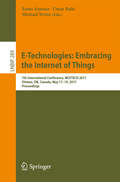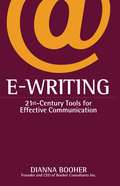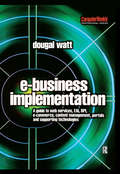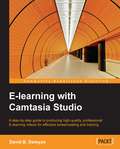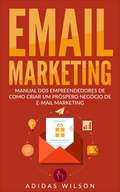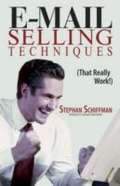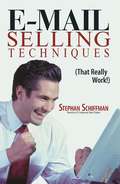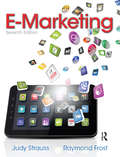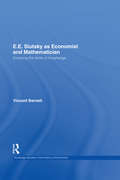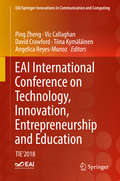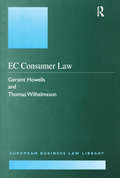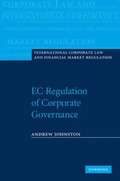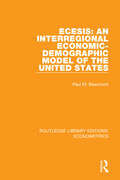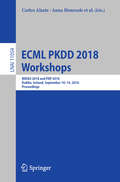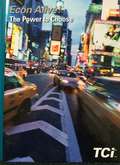- Table View
- List View
E-Sports-Management: Eine Einführung in die digitale Welt des Sports
by Anna Löchner Eva LindnerDas Thema E-Sports ist ein Phänomen des digitalen Zeitalters und hat sich mittlerweile zum Gesellschaftsphänomen des 21. Jahrhunderts entwickelt. Früher noch als Nischenmarkt belächelt, dominieren Video- und Onlinespiele mittlerweile die internationale Unterhaltungsbranche und E-Sports-Events füllen heute Stadien und locken Millionen von Menschen vor den Live-Stream. Mit Preisgeldern in Millionenhöhe, einem steigenden Interesse von Sponsoren und Investoren und einer zunehmenden Spieleranzahl hat sich der E-Sport zu einem gewaltigen Ökosystem mit einer Vielzahl von Stakeholdern entwickelt.Das vorliegende Herausgeberwerk beschäftigt sich mit einzelnen Bereichen des E-Sports-Managements und zeigt verschiedene Facetten auf. Durch die Verbindung von Wissenschaft und Praxis erhalten Stakeholder der E-Sports-Branche einen Überblick über die aktuellen Themen und Herausforderungen im E-Sports-Ökosystem.
E-Technologies: 7th International Conference, MCETECH 2017, Ottawa, ON, Canada, May 17-19, 2017, Proceedings (Lecture Notes in Business Information Processing #289)
by Esma Aïmeur, Umar Ruhi and Michael WeissThis book constitutes the refereed proceedings of the 7th International Conference on E-Technologies, MCETECH 2017, held in Ottawa, ON, Canada, in May 2017. This year’s conference drew special attention to the ever-increasing role of the Internet of Things (IoT); and the contributions span a variety of application domains such as e-Commerce, e-Health, e-Learning, and e-Justice, comprising research from models and architectures, methodology proposals, prototype implementations, and empirical validation of theoretical models. The 19 papers presented were carefully reviewed and selected from 48 submissions. They were organized in topical sections named: pervasive computing and smart applications; security, privacy and trust; process modeling and adaptation; data analytics and machine learning; and e-health and e-commerce.
E-Vanijya ani M-Vanijya Second Semester FYB.COM New NEP Syllabus - RTMNU: ई-वाणिज्य आणि एम-वाणिज्य दुसरे सत्र एफ.वाय.बी.कॉम. नवीन एन.इ.पी. अभ्यासक्रम - राष्ट्रसंत तुकडोजी महाराज नागपूर विद्यापीठ
by Dr Prakash Narayan Somalkar Dr Rajesh Sudhakar Dongreई-वाणिज्य आणि एम-वाणिज्य हे पुस्तक बी. कॉम. प्रथम वर्षाच्या दुसऱ्या सत्रातील Open Elective विषयासाठी तयार करण्यात आले आहे. या पुस्तकात माहिती तंत्रज्ञानातील प्रगती, ई-कॉमर्स आणि एम-कॉमर्सची संकल्पना, प्रकार, सेवा, फायदे, मर्यादा, इलेक्ट्रॉनिक पेमेंट पद्धती, आणि व्यवसायिक अनुप्रयोग यांचे सविस्तर विवेचन करण्यात आले आहे. यामध्ये ग्राहकाभिमुख ई-कॉमर्स, ई-रिटेलिंग, वेबसेवा, ई-मनोरंजन, बिझनेस-टू-बिझनेस व्यवहार, आणि विविध पेमेंट सिस्टीम्स (जसे की डेबिट कार्ड, मोबाईल वॉलेट, इंटरनेट बँकिंग, क्रिप्टोकरन्सी इ.) यांचे विवरण समाविष्ट आहे. तसेच, पारंपरिक वाणिज्य आणि ई-कॉमर्समधील फरक, तंत्रज्ञानाचे वैशिष्ट्य, उद्दिष्टे, फायदे-तोटे, आणि भारतातील माहिती तंत्रज्ञानाचा विकास यावरही सखोल माहिती देण्यात आली आहे. पुस्तक विद्यार्थ्यांसाठी सोप्या भाषेत लिहिले गेले असून प्रत्येक प्रकरणानंतर अभ्यासार्थ प्रश्न दिले आहेत. त्यामुळे हे पुस्तक व्यावसायिक जगतात डिजिटल व्यवहारांची ओळख करून देणारे आणि ई-गव्हर्नन्स व डिजिटल इंडिया सारख्या उपक्रमांची समज वाढवणारे अत्यंत उपयुक्त शैक्षणिक साधन ठरते.
E-Waste Management: Challenges and Opportunities in India
by Varsha Bhagat-GangulyThis book offers an extensive review of e-waste management in India, the world’s third‑largest producer of waste from electrical and electronic equipment. With a focus on the evolution of legalframeworks in India and the world, it presents impacts and outcomes; challenges and opportunities; and management strategies and practices to deal with e-waste. First of its kind, the book examines relevant concepts and issues from across 15 disciplines and six areas of policy making and will serve as a comprehensive knowledge base on electronic waste in India. It links key themes to the global context of Sustainable Development Goals and explores the convergence with technological, infrastructural, and social initiatives in e-waste management. A range of topics are discussed, such as resource efficiency policies; circular economy; toxicity; technicalities and complexities of e-waste management including role of the informal sector and need for recognising social and human costs in policy making. The book deals with the role of statistics; legal trends and reforms; linkages with green Agenda 2030 and UN initiatives; implementation of Extended Producer Responsibility (EPR); environmental factors; business prospects; consequences on human health; Life Cycle Impact Assessment; the ‘six Rs’ (Responsible use, Repair, Refurbish, Recycle, Recover and Reuse); recycling practices and problems, material flow and informal sector in trade value chain; fostering partnership between formal-informal sectors; safe disposal; alternatives to landfilling; role of jurisprudence and regulatory bodies; and education and awareness. It also includes a survey of pan-India initiatives and trajectories of law-driven initiatives for effective e-waste management along with responses from industries and producers. Timely and essential, this volume will be useful to scholars and researchers of environment studies, digital waste management, waste management, development studies, public policy, political ecology, sustainable development, technology and manufacturing, design and instrumentation, environmental and international law, taxation, commerce, electronic industry, economics, business management, metallurgy, and engineering, labour studies, as well as to policymakers, nongovernmental organisations, and interested general readers.
E-Writing
by BooherAre you guilty of e-mail "trigger finger"? Do you constantly "cc" people you never even see? What are today's rules for conducting business over the Internet? Now, The Elements of Style meets "the Miss Manners of memos" in the ultimate writing guide for the digital age. In an era when written communication in the workplace is more crucial than ever, at a time when many professionals all but completely eschew face-to-face dealings, E-writing is poised to become the new bible of business writing. Accessible and inviting, this Web-savvy "how-to" book promises to transform anxious e-mail hacks and mediocre memo writers into eloquent electronic scribes in no time at all. Inside, you will learn how to: combat counterproductive e-mail habits write authoritatively and persuasively, with a clear message that generates quick action handle e-mail and letter correspondence efficiently and effectively select an appropriate style for the audience you're addressing heighten your professional image, self-confidence, and career prospects. Practicing what she preaches, award-winning communicator and bestselling author Dianna Booher writes in a refreshingly straightforward style and has organized E-writing to make on-the-spot referencing a snap. Keep it handy; refer to it often -- and your online mailbox will never be the same again.
E-business Implementation: A Guide To Web Services, Eai, Bpi, E-commerce, Content Management, Portals, And Supporting Technologies (Computer Weekly Professional Ser.)
by Dougal Watt'E-business Implementation' is written as a complete guide to successful e-business delivery, from both a project management and a detailed technological perspective. E-business provides a powerful mechanism for organizations to increase productivity and lower costs. However, in order to utilise these considerable benefits, companies must ensure their e-business is implemented correctly and is appropriate to their market segment. 'E-business Implementation' provides a comprehensive guide to successful implementation and is divided into three parts:* Part one begins with a project management structure designed to deliver successful e-business functionality within time and budget, while avoiding the high failure rates common to many technology projects.* Part two details key concepts, technologies, products, vendors, benefits, limitations, and high-level design architectures for e-business, in a phased and risk-managed approach. These include publishing through the Internet and Intranets, portals and content management systems, transacting using e-commerce, integrating internal enterprise applications, integrating with external partners and suppliers, and responding in real-time to changing levels of demand through dynamic e-business and web services. * Part three details a set of critical foundation technologies that must be implemented correctly for the e-business initiative to be successful. These technologies include e-business development languages such as Java, XML and .Net, hardware platforms and their operating systems, security and networking systems, the Internet Domain Name System, and Open Source technologies.
E-learning with Camtasia Studio
by David B. DemyanIf you want to educate people using video learning techniques, this book is for you. Whether you are a teacher, a designer, or corporate learning staff and intend to deliver knowledge through videos, the exercises will benefit you, teaching the indispensable skills to produce and deliver effective educational content. No previous knowledge of Camtasia Studio or video production is required.
E-mail Marketing: Manual dos Empreendedores de como criar um próspero negócio de E-mail Marketing
by Adidas WilsonO mercado on-line está sempre mudando, uma tática de marketing eficaz pode ser obsoleta amanhã. O e-mail, no entanto, continua superando todos os canais de marketing. E por que o e-mail é tão potente? O que faz com que ele permaneça no poder? É fácil ignorar o email como um canal de marketing. Você não pode encontrá-lo na moda e emocionante como o Facebook. Mas tem vantagens importantes em relação a outros canais. Veja a demografia das plataformas populares de mídia social; mulheres usam mais o Pinterest, enquanto que a geração jovem prefere o Snapchat, mas em geral quase todos tem um endereço de e-mail. As pessoas enviam livremente seus endereços de e-mail e obviamente esperam receber e-mails seu. A presteza dos seus assinantes naturalmente aumenta suas taxas de conversão. Se o Facebook cair, você perderá todos os seguidores. O e-mail marketing, no entanto, permite que você tenha assinantes próprios. Use as mídias sociais para impulsionar sua lista de e-mail. A tecnologia automatizada de marketing está sempre se aprimorando e é por isso que o marketing por e-mail é tão eficaz, personaliza a experiência de um cliente, envia conteúdo segmentado para os consumidores e gera mais conversões e vendas. Personalizar o e-mail contribuiu muito para um aumento nas taxas de aberturas e a tecnologia de marketing tornou essa tarefa chata muito simples. Gênero: NEGÓCIOS E ECONOMIA / Publicidade e Promoção Gênero Secundário: NEGÓCIOS E ECONOMIA / Marketing / Direto Língua: Português BR Contagem de palavra: 9.088 Links de livros: Amazon
E-mail Selling Techniques
by Stephan SchiffmanThe sales culture of the twenty-first century is one where decisions are often made on the fly, calls are not thought out, and communication is based on onscreen ramblings, hitting Òsend,Ó and seeing what happens next. While e-mail has made it easier for salespeople to communicate than ever before, itÕs crucial to your success that your message is clear, concise, and to the point. Renowned sales guru Stephan Schiffman understands the unique benefits and challenges of using e-mail as a sales tool. E-mail Selling Techniques delivers dependable strategies to help you understand when and how to use e-mail to communicate with a client or prospect. E-mail Selling Techniques offers essential guidelines for: * The proper length and format of sales e-mails * Advice on tone and content * Tips for writing attention-grabbing subject lines * Identifying when a phone call might be more appropriate If you rely on computers and portable e-mail devices to do business, Stephan Schiffman will show you how to use technology to your advantage and get the deal done.
E-mail Selling Techniques That Really Work
by Stephan SchiffmanIf you rely on computers and portable e-mail devices to do business, Stephan Schiffman will show you how to use technology to your advantage and get the deal done.
E-marketing
by Raymond D. Frost Judy StraussFor courses in Internet Marketing or E-marketing This book teaches marketers how to engage and listen to buyers, and how to use what they learn to improve their offerings in today’s Internet- and social media-driven marketing environment. It brings traditional marketing coverage up-to-date with a thorough, incisive look at e-marketing planning and marketing mix tactics from a strategic and tactical perspective. The focus is on the Internet and other technologies that have had a profound effect on how marketing is approached today. Included is coverage of marketing planning; legal and global environments; e-marketing strategy; and marketing mix and customer relationship management strategy and implementation issues. A major revision, this seventh edition reflects the disruption to the marketing field brought about by social media. As such it covers many new topics that represent the changes in e-marketing practice in the past two years. Because of the ever-changing landscape of the Internet, the authors suggest reading this book, studying the material, and then going online to learn more about topics of interest. Features: Better understanding of new concepts in today’s electronic marketplace is accomplished as the book puts that new terminology into traditional marketing frameworks. Readers are encouraged to exercise critical thinking and attention to their own online behavior in order to better understanding the e-marketer’s perspective, strategies, and tactics–to think like a marketer. Although the focus is on e-marketing in the United States, readers also see a global perspective in the coverage of market developments in both emerging and developed nations. An entire chapter devoted to law and ethics, and contributed by a practicing attorney, updates readers on the latest changes in this critical area. Readers are guided in learning a number of e-marketing concepts with the help of some outstanding pedagogical features:-Marketing concept grounding helps readers make the connection between tradition and today. Material in each chapter is structured around a principle of marketing framework, followed by a look at how the internet has changed the structure or practice, providing an ideal bridge from previously learned material.-Learning objectives set the pace and the goals for the material in each chapter.-Best practices from real companies tell success stories, including new examples of firms doing it right.-Graphical frameworks serve as unique e-marketing visual models illustrating how each chapter fits among others.-Chapter summaries help readers review and refresh the material covered.-Key terms are identified in bold text within the chapter to alert readers to their importance.-Review and discussion questions are another device to be used for refreshing readers’ understanding of the material in the chapter.-Web activities at the end of each chapter help readers become further involved in the content.-This revision reflects the disruption to the marketing field based on social media. A major revision from the sixth edition, it includes many new topics, as dictated by changes in e-marketing practice in the past two years.-Three important Appendices include internet adoption statistics, a thorough glossary, and book references. NEW. Students get a broader look at social media as it is now integrated throughout the book, instead of confined to one chapter. NEW. A look a new business models continues and strengthens the approach of learning from real life examples. Added and described in detail are such models as social commerce (and Facebook commerce), mobile commerce and mobile marketing, social CRM, crowsourcing, and many important be less pervasive models such as crowfunding, freemium, and flash sales. NEW.Chapters 12, 13 and 14 were completely rewritten to reflect the move from traditional marketing communication tools to the way practitioners current describe IMC online: owned, paid and earned media. NEW. Readers see examples of many new and interesting technologies that are today providing marketing opportunities
E.E. Slutsky as Economist and Mathematician: Crossing the Limits of Knowledge (Routledge Studies In The History Of Economics Ser. #128)
by Vincent BarnettE.E. Slutsky is perhaps the Russian/Ukrainian economist most quoted by mainstream economists today. This is the first research monograph to examine the life and work of the internationally-renowned economist and mathematician. It does so from both a ‘history of economics’ perspective and a ‘history of science’ perspective, bringing these two strands together in order to demonstrate Slutsky’s enduring legacy as an innovative researcher and an influential intellectual. It also presents some of Slutsky’s lesser-known (and hitherto-unavailable) works in English translation.
E.I. du Pont de Nemours & Co.--1983
by Robert R. GlauberReviews changes in Du Pont's debt policy from 1965 to 1982. This period ended with a dramatic increase in Du Pont's debt level attendant upon the merger with Conoco. Students are asked to develop a new debt policy for Du Pont in the 1980s.
E.I. du Pont de Nemours & Co.: Titanium Dioxide
by W. Carl Kester David W. Mullins Jr. Robert R. Glauber Stacy S. DickDisequilibrium in the $350 million TiO2 market has prompted Du Pont's Pigments Department to develop two strategies for competing in this market in the future. The growth strategy has a smaller internal rate of return than the alternative strategy due to large capital outlays in early years and positive cash flows arising only in later years. However, it is the more valuable project on a net present value basis for all discount rates less than 21%. Students are faced with the task of converting strategic plans and objectives into free cash flow projections and determining a breakeven discount rate between these mutually exclusive projects. A decision about which strategy to pursue must then be made. Rewritten version of an earlier case by the same author.
E.I. du Pont de Nemours and Co.: The Conoco Split-off (A)
by Stuart C. Gilson Perry L. FaganAfter taking 30% of its Conoco oil and gas subsidiary public in the largest domestic initial public offering (IPO) in U.S. history, management of E.I. du Pont de Nemours and Co. (DuPont) is considering divesting its remaining interest in Conoco. This goal is to be accomplished through a relatively uncommon transaction called a corporate "split-off," under which DuPont's shareholders will be given the option to exchange their shares in DuPont for shares in Conoco (but, in contrast to a more conventional "spin-off," they are not obligated to exchange their shares). Management's objective in restructuring is to move DuPont away from its traditional energy and chemical business toward the life sciences (agriculture, biotechnology, and pharmaceuticals).
E.ON Corporate Strategy
by Forest Reinhardt Sebastian FrankenbergerExamines the corporate strategy of German energy giant E.ON. The firm is vertically integrated, horizontally diversified across electricity and natural gas, and active in numerous countries in Europe as well as in the United States. Explores the costs and benefits of the company's choices about its vertical, horizontal, and geographical scope. Considers the risks of economic regulation, increasing concerns about environmental externalities from carbon emissions and nuclear power, and political and price risks in upstream markets for fossil fuels.
E.T. Phone Home, Inc.: Forecasting Business Demand
by Frank V. Cespedes John F. CadyDescribes a process for forecasting market demand for an emerging technology--cellular radio. The student must critically evaluate the demand model and the market estimates, and modify them as appropriate in order to develop a marketing plan and budget.
EAI International Conference on Renewable Energy and Sustainable Manufacturing (EAI/Springer Innovations in Communication and Computing)
by Nguyen Thanh Hai Nguyen Xuan Huy Khalil Amine Tran Dai LamThis book presents the proceedings of the EAI International Conference on Renewable Energy and Sustainable Manufacturing (ICRESM 2023), which took place in Ho Chi Minh City, Vietnam, December 16-17, 2023. The conference serves as a platform for researchers, practitioners, industry experts, policymakers, and stakeholders to share their latest findings, innovations, and best practices in the areas of sustainable practices and technologies that reduce reliance on non-renewable resources and encourage the impacts of smart industry 4.0. The papers address global challenges relating to the sustainable manufacturing, energy security and green technologies, and discuss applications that aid in lowering carbon emissions, preserving the environment, and fostering economic growth by supporting renewable energy and eco-friendly manufacturing. Together, the participants disseminate the latest technological advancements, processes, and strategies that promote renewable energy and sustainable manufacturing.
EAI International Conference on Technology, Innovation, Entrepreneurship and Education: TIE'2017 (Lecture Notes in Electrical Engineering #532)
by David Crawford Victor Callaghan Angelica Reyes-Munoz Ping ZhengThis book presents the proceedings of the 1st EAI International Conference on Technology, Innovation, Entrepreneurship and Education (TIE 2017), which took place at Canterbury Christ Church University on September 11-12, 2017. The central theme of the conference is creativity and innovation, especially in relation to technology, business, education, social and political needs that make modern society flourish. The proceedings feature papers from a cross-disciplinary audience that explore the process of creativity and innovation. The goal is that the various disciplines can learn from each other and see how they might benefit from the cross-fertilization of practices.
EAI International Conference on Technology, Innovation, Entrepreneurship and Education: TIE'2018 (Lecture Notes in Electrical Engineering #532)
by David Crawford Angelica Reyes-Munoz Ping Zheng Vic Callaghan Tiina KymäläinenThis book presents the proceedings of the 2nd EAI International Conference on Technology, Innovation, Entrepreneurship and Education (TIE' 2018), which took place at Ravensbourne University London, London, UK, on September 4, 2018. The central theme of the conference is emerging technologies in relation to business, education, social and political needs that make modern society flourish. The proceedings feature papers from a cross-disciplinary audience that explore the process of creativity and innovation. The goal is that the various disciplines can learn from each other and see how they might benefit from the cross-fertilization of practices.
EC Consumer Law
by Geraint G. Howells Thomas WilhelmssonThis book will describe the development of European Community consumer law and seek to determine to what extent action by the European Community has promoted the interest of consumer protection. In doing so it will consider important areas relating to protection of the consumers economic interests and physical safety, as well as questions of access to justice. In addition to assessing the success of community consumer policy the authors will also put forward suggestions for ways in which consumer protection can be enhanced at the community level.
EC Regulation of Corporate Governance
by Andrew JohnstonAndrew Johnston examines EC regulation of national corporate governance systems through the lenses of economic theory and reflexive governance. By contrasting the normative demands of the neoclassical 'agency' model with those of the productive coalition model, he shows how their incompatibility required political compromise. Reflexive governance theory is then used to explain how progress has been possible. Through detailed analysis of both case law and positive regulation, the author highlights the move from positive to negative integration; the benefits as well as the limits of regulatory competition; and the significant role of reflexive techniques in both preventing market failure and enabling positive integration to proceed. The workable compromise that has emerged between market integration and continued regulatory diversity at national level demonstrates that procedural regulation can steer autonomous social subsystems towards greater responsibility and a better articulation of the public good.
ECESIS: An Interregional Economic-Demographic Model of the United States (Routledge Library Editions: Econometrics)
by Paul M. BeaumontOriginally published in 1989. ECESIS consists of 51 regional econometric models (one for each state and the District of Columbia) and a multiregional demographic model. Its distinguishing feature is the linking of sophisticated demographic accounts with sophisticated structural econometric models. This book, looking at how strong the interactions are between population dynamics and economic activity, determines to what extent the simultaneous economic-demographic interregional model provides improved projection and simulation properties over regional economic and demographic models used independently of one another.
ECML PKDD 2018 Workshops: MIDAS 2018 and PAP 2018, Dublin, Ireland, September 10-14, 2018, Proceedings (Lecture Notes in Computer Science #11054)
by Guido Caldarelli Tiziano Squartini Riccardo Guidotti Anna Monreale Carlos Alzate Livio Bioglio Valerio Bitetta Ilaria Bordino Andrea Ferretti Francesco Gullo Stefano Pascolutti Ruggero G. Pensa Celine RobardetThis book constitutes revised selected papers from two workshops held at the 18th European Conference on Machine Learning and Knowledge Discovery in Databases, ECML PKDD 2018, in Dublin, Ireland, in September 2018, namely: MIDAS 2018 – Third Workshop on Mining Data for Financial Applications andPAP 2018 – Second International Workshop on Personal Analytics and Privacy. The 12 papers presented in this volume were carefully reviewed and selected from a total of 17 submissions.

